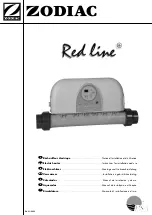
®
Outdoor Patio Heater Model No. GWU501E
Contact 1.800.762.1142 for assistance. Do not return to place of purchase.
page no.
6
Cleaning and Care
Notices
1. Abrasive cleaners will damage this product.
2. Never use oven cleaner to clean any part of heater.
3. Do not clean any heater part in a self cleaning oven. The extreme heat will damage
the finish.
4. More frequent cleaning may be required as necessary. It is imperative that control
compartment, burners and circulating air passageways of the heater be kept clean.
5. Spiders and insects can create a dangerous condition that may damage heater
or make it unsafe. Keep burner area clean of all spiders, webs, or insects. Clean
burner holes by using a heavy-duty pipe cleaner. Compressed air may help clear
away smaller particles.
6. Inspect heater before each use.
7. Have heater inspected annually and repairs should be made by a qualified service
person.
8. Check heater immediately if any of the following conditions exist:
a. The smell of gas in conjunction with extreme yellow tipping of burner flames.
b. Heater does not reach proper temperature.
Note: At temperatures less than 40ºF, heat output will be reduced.
c. Heater’s glow is excessively uneven
d. Burner makes popping noises during use.
Note: A slight pop is normal when burner is extinguished.
9. Carbon deposits may create a fire hazard. Keep dome and emitter clean at all times.
10. Do not clean heater with combustible or corrosive cleaners. Use warm, soapy
water.
11. Do not paint engine, engine access panel or dome.
12. This heater should be thoroughly cleaned on a regular basis.
13. After a period of storage and/or nonuse, check for leaks, burner obstructions and
inspect for any abrasion, wear, cuts to the hose.
Cleaning Surfaces
1. Wipe surfaces clean with mild dishwashing detergent or baking soda.
2. For stubborn surfaces use a citrus based degreaser and a nylon scrubbing brush.
3. Rinse clean with water.
Note:
While cleaning your unit, be sure to keep the area around the burner and pilot
assembly dry at all times. Do not submerge the control valve assembly. If the gas control is
submerged in water, do NOT use it. It must be replaced.
Maintance
To enjoy years of outstanding performance from your heater, make sure you perform the following
maintenance activities on a regular basis:
1. Keep exterior surfaces clean.
2. Air flow must be unobstructed. Keep controls, burner, and circulating air passageways
clean. Signs of possible blockage include:
Gas odor with extreme yellow tipping of flame.
Heater does NOT reach the desired temperature.
Heater glow is excessively uneven.
Heater makes popping noises.
Note:
In a salt-air environment (such as near an ocean), corrosion occurs more quickly than
normal. Frequently check for corroded areas and repair them promptly.
TIP:
Use high-quality automobile wax to help maintain the appearance of your heater. Apply to
exterior surfaces from the pole down. Do not apply to emitter screen or domes.
Storage
Between uses:
1. Turn Control Knob OFF.
2. Disconnect LP source.
3. Store heater upright in an area sheltered from direct contact with inclement weather
(such as rain, sleet, hail, snow, dust and debris).
4. If desired, cover heater to protect exterior surfaces and to help prevent build up in air
passages.
Note:
Wait until heater is cool before covering.
During periods of extended inactivity or when transporting:
1. Turn Control Knob OFF.
2. Disconnect LP source and move to a secure, well-ventilated location outdoors.
3. Store heater upright in an area sheltered from direct contact with inclement weather
(such as rain, sleet, hail, snow, dust and debris).
4. If desired, cover heater to protect exterior surfaces and to help prevent build up in air
passages.
5. Never leave LP cannister exposed to direct sunlight or excessive heat.
Note:
Wait until heater is cool before covering.
Troubleshooting
If the problem is:
And this condition exists:
Then do this
Pilot won’t light
Note: Heater operates at reduced efficiency below 40ºF (5ºC).
Tank valve is closed
Open valve
Blockage in orifice or pilot tube
Clean or replace orifice or pilot tube
Air in gas line
Open gas line and bleed it (pressing control knob in) for not more
than 1 - 2 minutes or until you smell gas
Low gas pressure with tank valve fully open
Turn tank valve OFF and replace tank
Igniter fails
Use match to light pilot; obtain new igniter and replace
Pilot won’t stay lit
Dirt built up around pilot
Clean dirt from around pilot
Connection between gas valve and pilot assembly is loose
Tighten connection and perform leak check
Thermocouple is not operating correctly
Replace thermocouple
Burner won’t light
Gas pressure is low
Turn tank valve OFF and replace tank
Blockage in orifice
Clear blockage
Control knob is not in ON position
Turn control knob to ON
Burner flame is low
Gas pressure is low
Turn tank valve OFF and replace tan
Outdoor temperature is less than 40ºF and tank is less than 1/4 full Use a full tank
Supply hose is bent or kinked
Straighten hose
Control knob fully ON
Check burner and orifices for blockage
Emitter glows uneven
Note: Bottom 1” of emitter normally does NOT glow.
Gas pressure is low
Turn tank valvue OFF and replace tank
Base is not on a level surface
Place heater on a level surface
Heater is level
Clean burner
Carbon build-up
Dirt or film on reflector and emitter
Clean reflector and emitter
Thick black smoke
Blockage in burner
Remove blockage and clean burner inside and outside



























